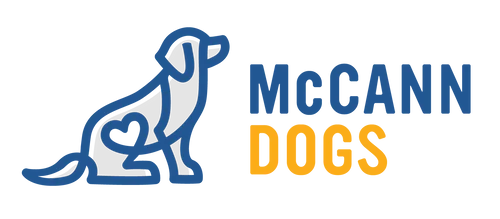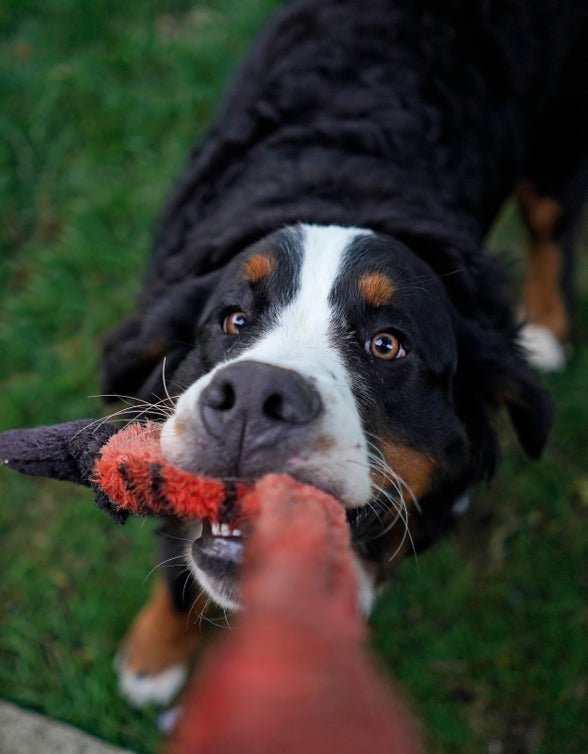Some of my favourite posts to write start with "The Truth About...."
I love helping to clarify some of the common misconceptions that surround dogs and training. Today, let's talk about the game of Tug!
People often tell us that they avoid tugging with their dogs because they've heard one of the common misconceptions that surround it. You may have heard one of these too:
- tugging will make your dog aggressive
- tugging will make your dog bite you
- tugging will make your dog possessive
There are a few more, but these are the major fallacies that we tend to hear being attached to the game of tug.
The truth is, possession and aggression can and will exist regardless of whether you choose to play tug with your dog. Tugging will not CREATE these issues, but it may nurture them if you allow your dog to tug with no rules.
As trainers, we know that the benefits of playing tug will far outweigh the risks, which get lower and lower as your dog gets more experience with the game of tug. These benefits are numerous and one of the biggest that we can site is the opportunity to build manners and understanding of rules surrounding toys and play with humans.
Simply put, tug affords us the opportunity to invest in our dog's understanding! Through play, we can offer reward, but we can also clarify rules. For example, through tug a dog can easily learn that they are responsible for their teeth and ensuring they don't 'miss' the toy. Dogs are very capable of controlling their mouths well. An 'accidental bite' is only an accident in the sense that the dog doesn't understand they're not allowed to bite. If they understand it's their job to be responsible for their teeth, they're more than capable of keeping them under perfect control!
Benefits of Tug
Dogs love to play and most are on the prowl for a good time if they're awake. We can use that interest in play to drive other behaviours. If play comes in the form of reward for doing things we want, over time the value of play will transfer to the skill itself.
This is known as transfer of value.
That's a very important thing.....
Transfer of value is what happens with any reward your dog finds motivating or reinforcing. The value of the reward becomes associated with the skill over time allowing the skill itself to hold value as we move away from consistent rewards and go to a variable reward schedule. Tug will also have the added benefit of transfering value to us since we bring the value of play. This is a great relationship aid!
Here's the kicker with transfer of value - you have to build the value for it to work!
I'll elaborate....
Transferring value from their favourite food rewards, for example, will take time. Generally speaking, food is innately rewarding to the dog - sitting on cue is not. To make sitting on cue become valuable, you need to use enough of the innate reward (food) for the dog to start associating the skill with the value provided through food. That's when a variable reward schedule will help eliminate the need to feed your dog for sitting each time they do so while still maintaining the dog's enthusiasm and understanding.
I think this highlights the benefit of tug as a reward system nicely. If you have a naturally toy motivated dog, playing Tug will be a HUGE benefit when it comes to transfer of value. Toys tend to build drive while food builds accuracy. Now, there are 2 distinctly different ways to reinforce and set the value of an exercise.
Want more drive to you on your recall? Toys, play and tugging are GREAT for helping to build it!
Rules of the Game will help teach lessons on manners
Now, let's use the game of tug to help with manners and emotional control.
Emotional control is your dog's ability to maintain listening skills and criteria even in the face of high stimulation. This is the moment before recess where kids sit at their desks, quiet as can be, waiting for the teacher to say...... GO! Then, the explosion!
Dogs of all breeds and ages need to be able to tap into emotional control so they can transition from calm to aroused and back to calm with ease. Being over-aroused is a nice thing when it's appropriately channelled, but it's important that our dogs are not left there without direction. Suppressing arousal as a tactic for control is doomed to fail. At some point, your dog will get aroused and you'll be powerless to stop the excitement if you've not trained in that state of mind.
Play and tug are nice ways to bring your dog in and out of arousal with ease so they can get really good at the transition. The more they practise going from one to the other through lessons like tug, or play and settle games, the easier it will be for them to settle when required.
Does your dog usually get excited about other dogs on the street? Do they get pumped when guests come over?
Lessons taught through tug and play will help you bring them down in other situations!
Rules of the Game
The rules of tug are up to you!!! Decide what you like and don't like and go with it! Maybe you don't want your dog jumping up on you during tug, maybe you don't mind! Maybe you want to allow growling and maybe not.
Rules should be clear for your dog and they should include the following at minimum:
1 - You get to start the game!
Rule #1 is that the dog doesn't start the game. The appearance of the toy doesn't start the game. YOU start the game. Pick a cue and stick to your guns! Do not allow your dog to try to take the toy until you've given them clear permission. This lesson will transfer to grabbing other things as well. When you're ready to start the game, be clear with your cue and have a blast!
2 - You end the game!
Another favourite is that you are in control of the end of the game and can involk that right anytime you wish. Ready to end a fun game of tug, you should get a quick release of the toy on one command. Dog not playing appropriately? End the game immediately. It's up to you when the fun ends.
Teach your dog to have a solid release command. Here's some help teaching 'drop it' from a previous blog post.
One of my favourite ways to use tug is as a means of strengthening my dog's drop it command. When I say 'drop it', the quicker the response from my dog, the quicker they get to re-engage with the toy. Now you can transfer value from the toy and tug, to the drop command by quickly rewarding a successful drop with a quick "get it" command! It's a Win-Win for the dog!!! I love watching my dogs turn onto this game - they can't spit the toy fast enough!
3 - The dog is responsible for their mouths
One of my favourite ways to teach my dogs to be careful and responsible with their teeth is through tug. With consistency, this lesson becomes invaluable for bite inhibition.
First and foremost, we must react quickly to end the fun the second we feel teeth. It doesn't matter how accidental it seems, if you feel teeth touch your skin even slightly, end the game instantly. Give the dog a short break and then start again. Repeat as many times as you need to.
It's a beautiful thing to see these lessons taking shape in a young dog's mind.
You can challenge their bite inhibition further by using smaller or different shaped toys to keep solidifying understanding!
In the end, it's your choice to play tug or not, but making the decision based on fact over fiction will ensure you're not unintentionally missing out on some really good training tools!
Until next time,
Happy Training!

